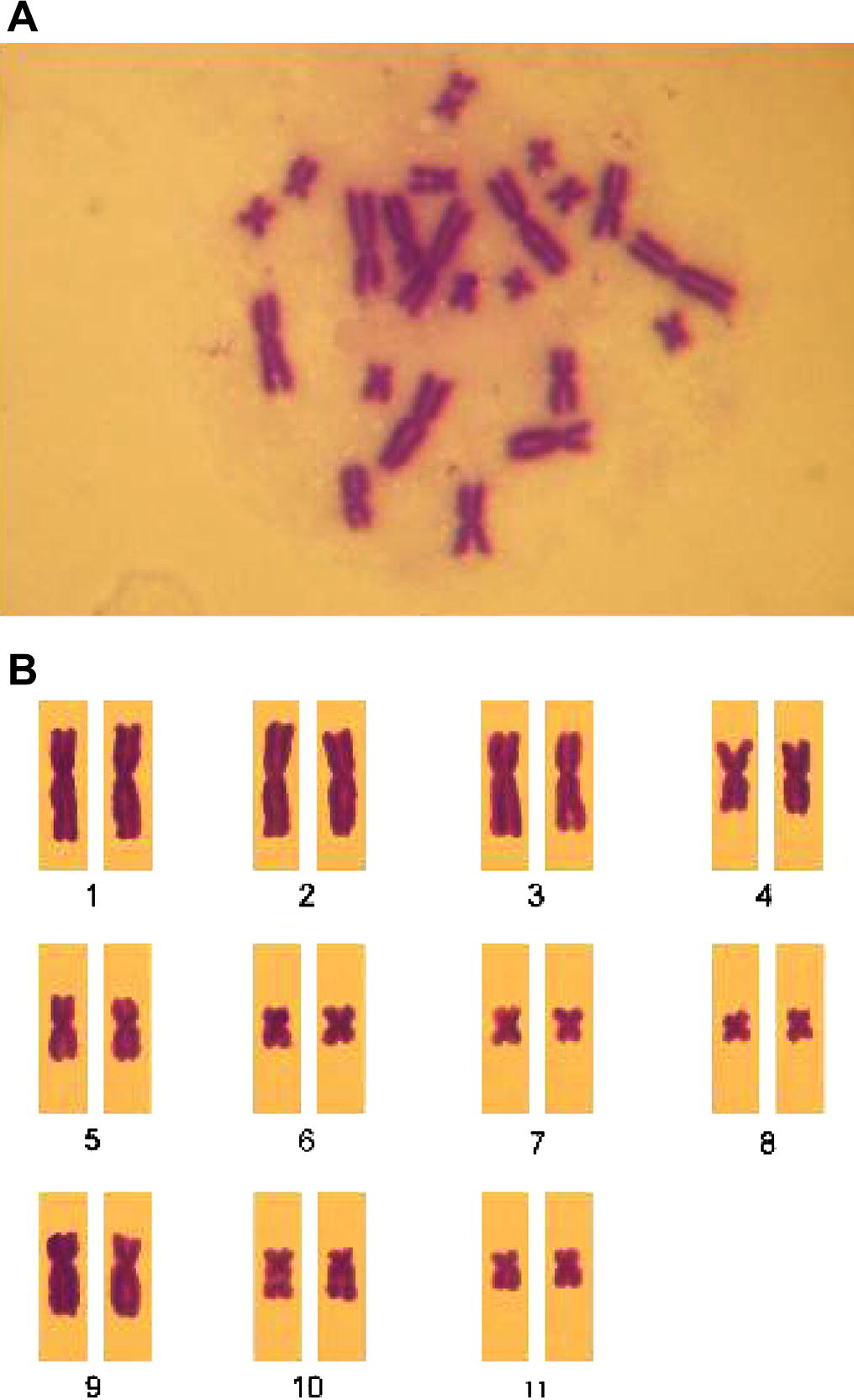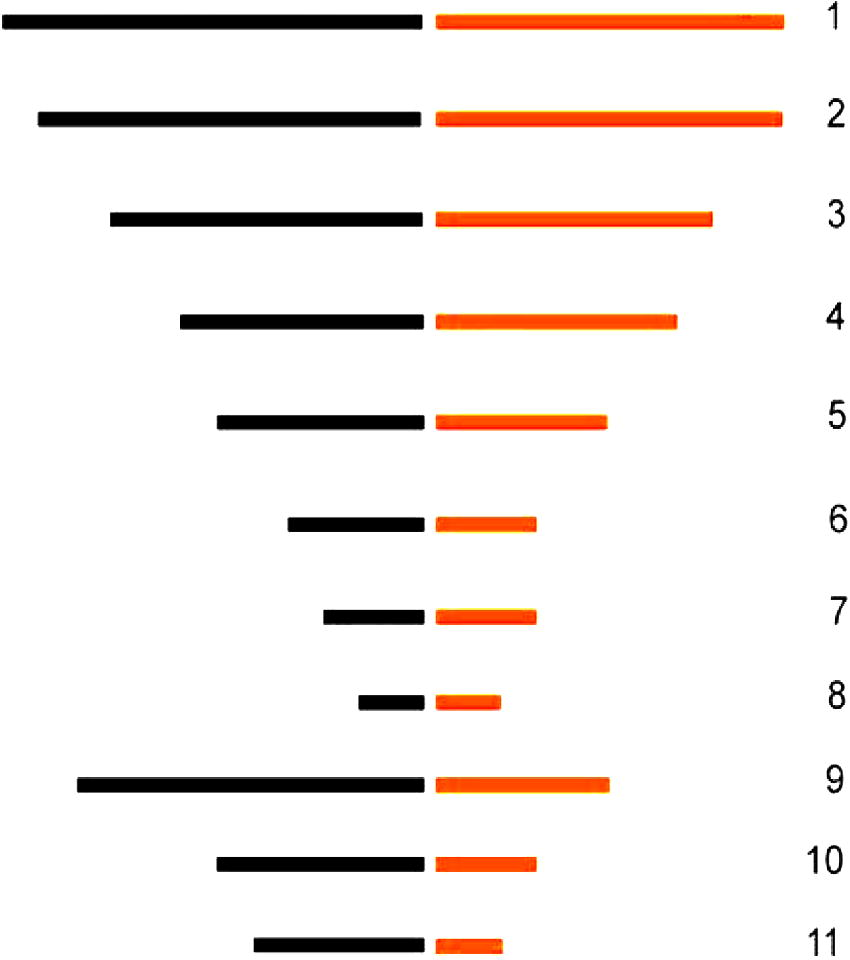Translate this page into:
First report of the karyotype of Bufo dhufarensis from Saudi Arabia
*Corresponding author azsaleh@ksu.edu.sa (A.A. Al-Saleh)
-
Received: ,
Accepted: ,
This article was originally published by Elsevier and was migrated to Scientific Scholar after the change of Publisher.
Abstract
We report for the first time the description of the karyotype of the Dhufar toad Bufo dhufarensis from Saudi Arabia. This karyotype consists of 22 chromosomes and could be classified into two categories; eight pairs of metacentric and three pairs of submetacentric chromosomes. The 10th pair of this karyotype has a secondary constriction on the long arms of both male and female chromosomes. The fundamental number of this species is 44.
Keywords
Amphibian
Karyotype
Chromosome
1 Introduction
It is of a surprise to find several amphibian species abundant to a harsh environment such as in the Arabian Peninsula. The work of Balletto et al., 1985 is considered as the more precise surveys dealing with the morphological and classification of Arabian anura. However, there are few research on the distribution of frogs and toads in kingdom of Saudi Arabia and neighboring country such as Yemen (Schmidt, 1953; Hass, 1957, 1961; Briggs, 1980, 1981).
According to the literatures, Bufo arabicus is the first toad to be classified from the region (Heyden, 1827) but recent research on the amphibian chromosomes of the Arabian Peninsula has just started, and few paper have been published (Al-Shehri and Al-Saleh, 2005a,b, 2008).
Therefore, it is very important to study and protect such creatures because they are under grave threat not only due to general habitat alteration but also to climate change, pollutant and the emergence of deadly and infectious diseases such as fungal disease which has been due to global warming. Amphibian and reptile populations have declined by 75% since 1970, which indicate to the extinction danger that amphibian might face in the near future (Whitfield et al., 2007).
In this paper we are going to describe for the first time the diploid number of chromosomes for Bufo dhufarensis from Kingdom of Saudi Arabia using bone marrow cells treated with colchicine in vivo.
2 Materials and methods
Samples of males and females of B. dhufarensis Parker were collected from Al-Derayya village, Riyadh province of Kingdom of Saudi Arabia. Each sample was injected interaperitoneal with 0.2 ml of colchicine solution (1 mg/ml) for 24 h before being killed. Chromosome preparations followed the method described by Al-Shehri and Al-Saleh (2008) and well-spread metaphases chromosomes were analyzed and photographed. The nomenclature proposed by Levan et al. (1964) was followed for the classification of each homologous pair.
3 Results
For the first time we report and describe the karyotype of B. dhufarensis, which has been collected from Riyadh region, Kingdom of Saudi Arabia. The karyotype consists of 22 chromosomes, eight pairs of metacentric and three pairs of submetacentric chromosomes (Figs. 1 and 2).
(A) Photomicrograph of metaphase spreading from male B. dhufarensis. (B) Karyotype of male B. dhufarensis.

(A) Photomicrograph of metaphase spreading from female B. dhufarensis. (B) Karyotype of female B. dhufarensis.
The measurement of the length of the chromosomes is calculated for seven different karyotypes and the relative length is represented in Table 1. Metacentric chromosomes are classified according to their length to three types:
-
Chromosomes 1–3 are large size chromosomes.
-
Chromosome 4 is medium size chromosomes.
-
Chromosomes 5–8 are small size chromosomes
| Chrom. no. | Short arm p | Long arm q | Total length q + p | Arm ratio q/p | Type of centromere |
|---|---|---|---|---|---|
| 1 | 4.36 | 5.23 | 9.59 | 1.2 | M |
| 2 | 4.36 | 4.8 | 9.16 | 1.1 | M |
| 3 | 3.49 | 3.92 | 7.41 | 1.1 | M |
| 4 | 3.05 | 3.05 | 6.1 | 1.0 | M |
| 5 | 2.18 | 2.62 | 4.80 | 1.2 | M |
| 6 | 1.31 | 1.74 | 3.05 | 1.3 | M |
| 7 | 1.31 | 1.31 | 2.62 | 1 | M |
| 8 | 0.87 | 0.87 | 1.74 | 1 | M |
| 9 | 2.18 | 4.36 | 6.54 | 2 | SM |
| 10 | 1.31 | 2.62 | 3.93 | 2 | SM |
| 11 | 0.87 | 2.18 | 3.05 | 2.5 | SM |
The submetacentric chromosomes are classified according to the length to two types:
-
Chromosome 9 is medium size chromosome.
-
Chromosomes 10–11 are small size chromosomes.
The 10th pair of this karyotype has a secondary constriction on its long arms and could be considered as a marker chromosome for this species. The type of centromeres has been determined according to the formula of Matthey and the finding is represented in Fig. 3 and the fundamental number (FN) has been calculated to be 44 (Table 2). Our observations confirm the lack of heteromorphic sex chromosomes in this species. M = Metacentric chromosome. SM = Submetacentric chromosome.
An ideogram of B. dhufarensis constructed on the basis of chromosome numbers and the position of the centromere.
Type centromere
Haploid no. N
Diploid no. 2N
Fundamental no. FN
M
8
16
32
SM
3
6
12
Total
11
22
44
4 Discussion
The karyotype of B. dhufarensis is asymmetric chromosomes consisting of diploid number of 22 chromosomes. This report is representing for the first time the karyotype of the toad B. dhufarensis. The finding of 22 chromosome diploid number is in consequence with the bufonidae diploid chromosomes number which has been found to have karyotypic uniformity and consist of 22 chromosomes (Ullerich, 1966; Volpe and Gerhardt, 1968; Doyle and Beckert, 1970; Azevedo et al., 2003; Al-Shehri and Al-Saleh, 2008).
The heterogametic sex is male in all mammals and female in almost all birds but in amphibians the case is different (Nakamura, 2009). The pioneer authors had discussed the occurrence of sex chromosomes in Amphibians and some assumed heterogamety in Anura while other did not accept heteromgamety in this group of animals (Stohler, 1928; Witschi, 1933; Saez et al., 1935; Galgano, 1941; WickBom 1945; Yosida, 1957; Saez and Brum, 1960; Becak, 1968; Rabello, 1970). A review by Schmid and Steinlein (2001) indicated that sex chromosomes among amphibians can be divided into three categories, male hetero, female hetero and homogamety. This species has been found to be of the type of homogametic sex chromosomes.
A recent report confirms that karyotyping analyses of the cane toad Bufo marinus have so far failed to identify heteromorphics sex chromosomes (Abramyan et al., 2009). The uniformity of sex chromosomes among toads seems to be accepted, and there are several papers indicating such uniformity (Miura, 1995; Kasahara et al., 1996; Cavallo et al., 2002; Azevedo et al., 2003; Siripivasing et al., 2008).
An interesting finding by Hayes (1998) stated that most amphibians lack morphologically distinguished sex chromosomes and suggested that environment influences sex determination. Bergero and Charlesworth (2009) confirm recently that heteromorphics sex chromosomes are a homologous pair in origin evolved from normal pair of homologous chromosomes.
5 Conclusion
We can stress the fact that this study not only confirm for the first time that the diploid number is 22 but confirms that B. dhufarensis is endemic to the Arabian Peninsula.
References
- Z and W sex chromosomes in the cane toad (Bufo marinus) Chromosome Res.. 2009;17:1015-1024.
- [Google Scholar]
- Karyotype of Amphibian in Saudi Arabia. 1. The karyotype of Rana ridibunda. J. Biol. Sci.. 2005;5:335-338.
- [Google Scholar]
- Karyotype of Amphibian in Saudi Arabia. 2. The karyotype of Hyla savignyi. J. Biol. Sci.. 2005;5:768-770.
- [Google Scholar]
- Karyotype of Amphibian in Saudi Arabia. 3. The karyotype of Bufo regularis. Asian J. Cell Biol.. 2008;3:67-71.
- [Google Scholar]
- Comparative cytogentic studies of Bufo ictericus, BpParacnemis (Amphibia, Anura) and an intermediate form in sympatry. Gent. Mol. Biol.. 2003;26:289-294.
- [Google Scholar]
- The evolution of restricted recombination in sex chromosomes. Trends Ecol. Evol.. 2009;24:94-102.
- [Google Scholar]
- Briggs, J., 1980. The green frog population of eastern Saudi Arabia. Abstract of Paper presented to annual joint meeting of the Society for the study of Amphibians and Reptiles – Herpetologists league, Milwaukee.
- Population structure of Rana ridibunda in the Al-Qatif Oasis. Proc. Saudi Biol. Soc.. 1981;5:333-345.
- [Google Scholar]
- Karyological and flow cytometric evidence of triploid specimens in Bufo viridis (Amphibia Anura) Eur. J. Histochem.. 2002;16:159-164.
- [Google Scholar]
- Chromosome characteristics of bufonidae among species and within populations. Caryologia. 1970;23:145-154.
- [Google Scholar]
- La variazione dei chiasmi nei maschi e negli intersessuati di Rana esculenta L. Arch. Ital. Anat. Embriol.. 1941;56:127-165.
- [Google Scholar]
- Sex determination and primary sex differentiation in amphibians: genetic and developmental mechanisms. J. Exp. Zool.. 1998;281:373-399.
- [Google Scholar]
- Heyden, C.H.H., 1827. Atles zu der reise im nordliechen Afrika von Eduard Ruppell. Frankfurt a.M Bronner.
- Chromosome banding in three species of Brazilian toads (Amphibia-Bufonidae) Rev. Brasil. Genet.. 1996;19:237-242.
- [Google Scholar]
- The late replication banding patterns of chromosomes are highly conserved in genera Rana, Hyla and Bufo (Amphibia, Anura) Chromosoma. 1995;103:567-574.
- [Google Scholar]
- El problema de los cromosomas sexuales en los anfibios. Rev. Soc. Argent. Biol.. 1935;11:173-176.
- [Google Scholar]
- Sex chromosome, sex-linked genes and sex determination in the vertebrate class amphibian. EXS. 2001;91:143-176.
- [Google Scholar]
- The identification of the sex chromosome and karyotype of four toad species (Genus Bufo) in Thailand bt T-lymphocyte cell culture. Cytologia. 2008;73:229-241.
- [Google Scholar]
- Cytologische Untersuchungen an den Keimdrusen Mitteleuropuischer Kroten (Bufo viridis Laur, B. calamita Laur and B. vulgaris Laur) Z. Zellf. Mikr. Ant. Gewebelehre.. 1928;7:400-475.
- [Google Scholar]
- Karyotyp und DNS-Gehalt von Bufo bufo, B. Viridis. B. bufo × B. vindis and B. calamita (Amphibia, Anura) Chromosoma. 1966;18:316-341.
- [Google Scholar]
- Somatic chromosomes of the marine toad Bufo marinus (Linne) Copeia. 1968;3:570-576.
- [Google Scholar]
- Amphibian and reptile declines over 35 years at La Selva, Costa Rica. PNAS. 2007;104:8352-8356.
- [Google Scholar]
- Cytological studies on Dipnoi, Urodela, Anura and Emys. Hereditas. 1945;31:241-346.
- [Google Scholar]
- Contributions to the study of amphibian germ cells. I. Chromosomes in spermatocyte divisions of five North American species of toads. Cytologia. 1933;4:174-181.
- [Google Scholar]
- Sex chromosomes of the tree frog, Hyla arborea japonica. J. Fac. Sci. Hokkaido Univ. Serv. VI Zool.. 1957;13:352-358.
- [Google Scholar]







